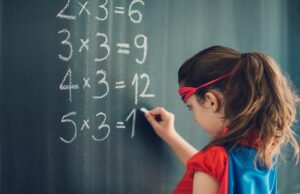Reading is by no means easy when you don’t know all the ways to spell the sounds of the French language. This is why the good reader is the one who has learned very early and memorized all the correspondences between the written signs and the sounds of the language. The quality of these achievements makes reading almost automatic, thus freeing up mental resources to understand the texts read.
Similarly, doing calculations when you don’t know your teaching multiplication tables is by no means easy. Pushing the analogy, we could compare letters and figures, words and numbers, calculations and texts. Calculations are a form of elaborate combinatorics: if each combination becomes complex due to a lack of knowledge of elementary operations (addition and multiplication tables), it is all mathematics that becomes indigestible and a source of frustration.
Let’s end this comparison by saying that if some children deviate from reading because of an insufficient mastery of combinatorics, making reading complicated, similarly, ignorance of elementary calculations deviates children from mathematics. Addition tables are not a problem. It is the multiplication tables that children seem to no longer be able to learn, as many parents attest.
To say that this learning has been neglected in schools lately would be an understatement. The action of memorizing the multiplication tables is an activity considered too stupid by modern pedagogues who strongly advise against dwelling on it in the “didactic sequences”. The arithmetic handicapped will always be able to use calculators, just as the illiterate have become accustomed to spell checkers. But the crutches do not eliminate the handicap which will prevent the first from appreciating mathematics and the second from becoming a reader.
Learn multiplication tables, child’s play
In reality, learning the multiplication tables is child’s play. Before sticking to it, it is important that the child understands what a multiplication is with examples that allow him to manipulate, to understand the difference between 2×5 and 5×2 while discovering why the result is the even, to make the link between addition and multiplication. Once this is understood and assimilated, multiplication tables can be learned at any age because it is simply a matter of memorizing associations of numbers.
It is good to know that 7×8 is 56 without having to recount by more or less rapid strategies, not exempt from possible error. Learning that 7×8 is 56 is like learning a new word in the French language: you have to learn its spelling, which does not prevent you from relying on mnemonic devices or etymological reasons to remember it. The same is true with multiplication.
Knowing his tables is good. Knowing all the multiplications out of order is much better. The final objective of this learning is to be able to carry out simple multiplications in all possible contexts: in mental arithmetic, in a succession of written calculations, in fraction simplifications (which requires knowing them backwards: 24, it’s 3×8 but also 6×4).
Knowing all the multiplication tables from 1 to 10 as soon as possible avoids making mistakes in basic calculations at any level of study: a preparatory class teacher pointed out that his students would pass the competitions of engineer if they were not mistaken in multiplications as simple as 6×7 or 4×8.
Up to you
Hoping to have convinced you, here are some ways to facilitate this learning. The summer period can be a good time to engrave multiplication in the mind of your children by devoting only a few minutes to it a day.
Beforehand, we invite you to check that your children have understood the number and the meaning of multiplication. Elisabeth Nuyts’ explanations on this subject are enlightening. Its file on mathematics will allow you to take up step by step the notions of figure, number, tens, the deep meaning of elementary operations, etc. This work is remarkable because it is enough to follow the indications, the proposed activities and the exercises so that the child understands the deep logic of mathematics. After such a treatment, mathematics will no longer be viewed in the same way by your child, and perhaps also by you.



